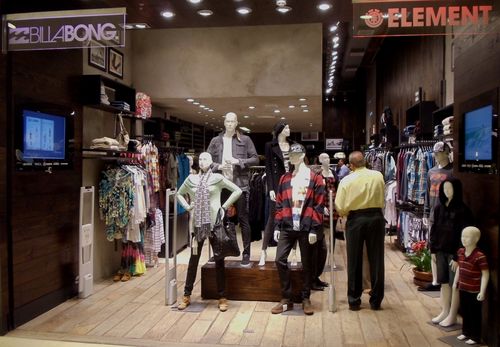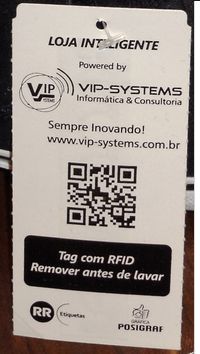A new RFID-enabled system being tested at Billabong sportswear clothing store in the Iguatemi Alphaville shopping mall located in the Brazilian city of Barueri, reportedly increased the number of visitors to the store by more than 300 people in the first week. The store’s manager, Marcelo Chiaparini, says the boost to the store’s traffic, fueled by curiosity about the technology and how it was being used, also led to higher sales.
The system, launched at the store on Aug. 9, includes RFID data management software from VIP-Systems and EPC Gen 2 passive RFID tags from RR Etiquetas and UPM RFID. The software is integrated with the store’s legacy point-of-sale (POS) and back-office inventory systems.
The tags, which are on every item in the store, provide staff with inventory and point-of-sale data, and the RFID system includes an electronic article surveillance (EAS) application coupled with cameras at the exit. Customers can use the RFID system to view information about products on the sales floor and in its fitting rooms, as well as a way to request more items from staff.
VIP-Systems, which developed the system, was launched in 1997 to provide technology for access control, industrial and retail applications. The company’s president, Regiane Relva Romano, is completing her Ph.D. in retail with a focus on how technology can improve customer experience. The RFID applications the company developed for Billabong’s deployment include features such as a Smart POS, Smart Dressing Room, Smart Logistics, Smart Exhibitor, Smart Inventory, Smart Loss Prevention, Smart Replenishment and others that can improve the interactivity and the mobility of customers and employees.
Billabong implemented a total of 15 VIP-Systems applications, all integrated in the store, which carries about 5,000 items on the sales floor at any given time, with several additional garments for each size and style stored in the back room. The RFID portion of the system includes just three RFID interrogators: one handheld reader for staff to conduct inventory of its products in the back room; one fixed reader with multiple antennas for the Smart Exhibitor and Smart Shelves applications, and one with multiple antennas to read tags in the dressing room, at the point of sale and at the front door.
In addition, Billabong deployed non-RFID solutions, also developed by VIP-Systems, such as an “Interactive Mirror,” which allows customers to take pictures of themselves wearing a pair of sunglasses, write messages on a touch screen mounted in a kiosk and send the photos to a social network or e-mail.
However, the RFID technology is at the center of the solution, providing inventory tracking, as well as consumer information and entertainment. All items in the store have been tagged by staff, says Chiaparini. Beginning in January 2012, the store hopes that all items will arrive, already tagged, at the store, with the tagging carried out beforehand at a distribution center run by the merchandise’s manufacturer. Once the tags are being attached prior to shipping to the Billabong store, receiving new items will be simpler for store staff. They will simply wave their EPC Gen 2 Convergence Systems Ltd. (CSL) handheld reader near a new box of products. Until then, staff members need to unpack the box and scan a bar code on each item’s label. Although this pilot uses a CSL reader, Romano indicates that any of the major UHF handheld readers would work in such a system.
Once items are received via RFID or bar code, the data can then be stored on VIP-Systems software on the store’s back-end system. This week the store will conduct its first inventory check of all items in the back room with the handheld reader by passing the reader past each product, testing the new RFID system. While typically an inventory check of the back room takes staff about four hours, Chiaparini says, he has hopes this inventory process will require only one hour.
The store is also equipped with VIP-Systems Smart Shelves with built-in Impinj RFID antennas wired to an Impinj reader to read the ID numbers of tags and store that data to provide a real-time inventory count that indicates where each item is on the sales floor, and whether any items need to be moved because they have been mis-shelved.
The Smart Exhibitor system allows customers to learn more about the items they are viewing in the store. They simply remove an item from the shelf and hold the tag next to an Impinj RFID antenna. Based on the tag’s ID number read by that antenna, VIP-Systems software transmits, via a Wi-Fi connection, data to an iPad, which then displays information about other products that might best accompany that item.
When customers bring garments into the Smart Dressing Room, an RFID antenna captures the ID numbers on tags attached to those items. A touch screen on the dressing room mirror then displays products that coordinate with those brought into the room, as well as colors and sizes available in the store. A customer can then press a prompt on the screen to send a text message to the mobile phone of a staff member to request additional items.
At the cash register, an RFID antenna installed under the counter reads tags of items placed on the counter for the purpose of being purchased and sends that information to the VIP-Systems software, integrated with the store’s inventory management system, which then updates sales data by moving the tag’s ID number from the “unsold” category, to “sold.” An Intelligent Deactivator function also allows a customer to have the tag deactivated by staff, using a kill command to turn off the tag’s transmission functionality.
Finally, when the customer exits the store, an RFID antenna captures the tag ID numbers and checks their status in the inventory management system. If, by chance, the system determines that someone leaves with a product not paid for, the system will trigger an audible alarm and will record a video of the incident.

“RFID technology is important for retailers,” says Romano, who says those likely to benefit from RFID tagging include manufacturers, logistics providers, distribution centers, retailers and consumers.
The Billabong store, which opened at the Iguatemi Alphaville location about three months ago, has a young clientele with an interest in innovation, Chiaparini says. As a result, the store, Romano comments, “values innovation and understands that technology can provide a differentiated shopping experience.” She adds that because the store is not big, “it’s a perfect place to test the concept and then enhance the whole network,” by making changes to any of the hardware or software functions based on the results of the test.



